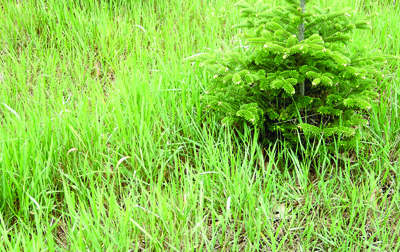Quackgrass
September 4, 2015
Elymus repens (L.) Gould
Life cycle
Erect, rhizomatous perennial.

Patch of quackgrass.
Leaves
Leaves are rolled in the bud, hairless to sparsely hairy above and up to 8 inches long. Leaf sheaths are hairless except those near the base, which may be sparsely hairy. Clasping, claw-like auricles are present at the collar region.
Ligule
Very short, membranous ligule.
Stems
Erect and clump-forming, up to 4 feet tall. Plants spread by thin, yellowish to white, sharp-tipped rhizomes.

Sharp-tipped rhizome of quackgrass.
Flowers and fruit
The seedhead is a two- to 10-inch-long, slender, unbranched spike made up of several alternating spikelets arranged edgewise on the stem. Each spikelet contains up to eight straw-colored, lance-shaped seeds. Each seed has a short to prominent awn.

Quackgrass seedhead.
Reproduction
Seeds and rhizomes.
Print a PDF of this page: Quackgrass
Other Documents in this Series
You Might Also Be Interested In
-
Reciprocal Research: A Guidebook to Centering Community in Partnerships with Indigenous Nations
Published on April 22, 2021
-
MSU students partner with Michigan communities to improve trail access
Published on May 30, 2025
-
How to support children after one year of virtual learning
Published on March 17, 2021
Accessibility Questions:
For questions about accessibility and/or if you need additional accommodations for a specific document, please send an email to ANR Communications & Marketing at anrcommunications@anr.msu.edu.



 Print
Print Email
Email




